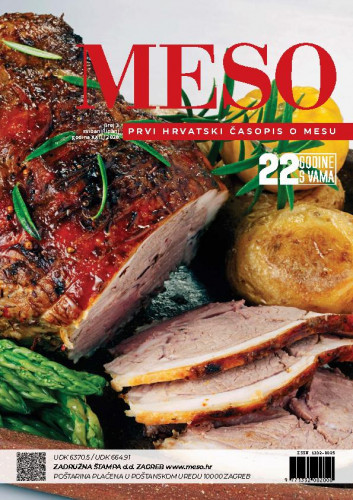Consumers often mix pasteurised meat products from the subgroup of smoked meat with a subgroup of meat products known as canned meat. The aim of this study was therefore to determine their physicochemical parameters and sensory properties of smoked meat and canned meat subgroups of pasteurised meat products on the Slovenian market. Chemical analyses of the content of ash, sodium chloride and phosphates, thiobarbituric acid number (TBA), instrumental measurements of the proximate composition (NIR), colour (CIE L*, a*, b*) and texture (Texture Profile Analysis) as well as the evaluation of sensory properties (Descriptive Analysis Method) were performed on 33 products. The products of smoked meat had a higher content of protein, ash, total phosphates and sodium chloride than the products of canned meat. All products were oxidatively stable (low TBA number). The products of smoked meat were darker (lower L* values) and redder in cross-section (higher a* values), they were tougher, gummier, more difficult to chew, more cohesive and less elastic in texture (Texture Profile Analysis) than the products of canned meat. The panel of experts evaluated the products of both subgroups with a similar average overall impression. Compared to the products of the canned meat, the products of the smoked meat showed worse slice colour uniformity, they contained a higher level of gelatinised connective tissue on the slice, had a worse slice connectivity, the texture of a slice was firmer with coarser fibres, they were saltier, with a less pronounced metallic and rancid aroma and a more pronounced bitter, acidic and odd aroma. Chewiness, gumminess, cohesiveness, hardness and elasticity (texture parameters) loaded strongly on the quality parameters of all products (Factor analysis). Furthermore, linear discriminant analysis confirmed that the products of the subgroups smoked meat and canned meat differ in their physico-chemical and sensory profile.; Potrošači toplinski obrađene mesne proizvode (pasterizacija) iz podskupine dimljenih proizvoda (polutrajni suhomesnati proizvodi od jednog komada mesa), često miješaju s podskupinom polutrajnih proizvoda od komada mesa (“konzerve”). Cilj je ovog rada, stoga, bio utvrditi fizikalno-kemijske značajke i senzorska svojstva proizvoda iz ovih podskupina na slovenskom tržištu. Kemijskim analizama provedenima na 33 proizvoda utvrđeni su udio pepela, soli i fosfata te TBA vrijednost (test tiobarbiturne kiseline) i izvršena instrumentalna mjerenja kemijskog sastava (NIR), boje (CIE L*, a*, b*) i teksture (analiza profila teksture), kao i procjena senzorskih svojstava (metoda opisne analize). Dimljeni mesni proizvodi imali su veći udio bjelančevina, pepela, ukupnih fosfata i soli od konzerviranih mesnih proizvoda. Svi proizvodi bili su oksidativno stabilni (niska TBA vrijednost). Dimljeni mesni proizvodi bili su tamniji (niže vrijednosti L*) i crveniji u presjeku (više vrijednosti a*), žilaviji, ljepljiviji i teži za žvakanje te kohezivnije i manje elastične teksture (analiza teksturnog profila) od polutrajnih proizvoda od komada mesa. Stručna skupina proizvode iz obje podskupine ocijenila je sličnim prosječnim ukupnim dojmom. U usporedbi s polutrajnim mesnim proizvodima, dimljeni mesni proizvodi pokazali su lošiju ujednačenost boje kriški, sadržavali višu razinu želatiniziranog vezivnog tkiva u kriški, imali lošiju povezanost kriške, tekstura kriške bila je čvršća i sadržavala grublja vlakna, bili su slaniji, s manje izraženom aromom metala i užeglosti te izraženijom gorkom, kiselom i neobičnom aromom. Lakoća žvakanja, ljepljivost, kohezivnost, tvrdoća i elastičnost (značajke teksture) kod svih su proizvoda značajno utjecale na značajke kvalitete (faktorska analiza). Osim toga, linearnom analizom različitih potvrđeno je da se proizvodi iz navedemih podskupina razlikuju po svom fizikalno-kemijskim i senzorskom profilu.
Sažetak

 Meso : prvi hrvatski časopis o mesu : 22,3(2020) / glavna i odgovorna urednica, editor-in-chief Katarina Lučić.
Meso : prvi hrvatski časopis o mesu : 22,3(2020) / glavna i odgovorna urednica, editor-in-chief Katarina Lučić.